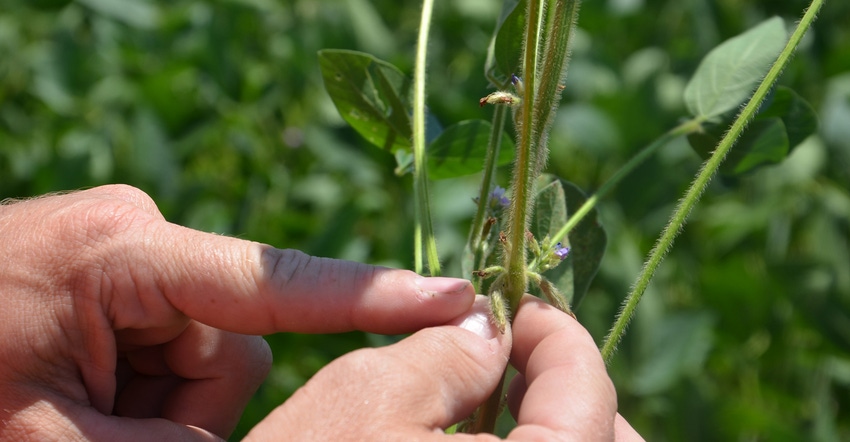
You can build a schedule of what to expect in soybeans and what management decisions you might be able to make based upon stages of growth. Once pods start to form, soybeans have entered reproductive stage R3. That happened in late July in most fields this year.
“They stay in R2 and R3 for up to a couple weeks or more in each stage,” says Steve Gauck, a Beck’s sales agronomist based near Greensburg, Ind. Beck’s sponsors Soybean Watch ’18.
“Past trials in Beck’s Proven Farm Research trials and in other work indicate that if you’re going to apply a fungicide in soybeans, the R3 stage is probably the time to do it,” he says. “You can still apply fungicides in R4, but most results indicate less bang for your buck in terms of increased yield.”
Remember that you need enough yield kick to pay for the fungicide and application cost first. Anything above that goes to the bottom line in profit, Gauck notes.
In the Crop Watch ’18 field at the R3 stage, Gauck found some septoria brown spot lower in the canopy, and a few leaves here and there with frogeye leaf spot.
Farmers in Illinois traditionally pay more attention to septoria leaf spot, and some treat to control it, but so far in Indiana, most farmers haven’t felt it justified treatment on its own, he says.
Frogeye leaf spot was minimal. It can be resistant to certain strobilurin fungicides, but there’s no easy way to tell in advance if it is.
Fungicide approach
So far in Indiana and points east, there appear to be two camps when it comes to applying fungicides on soybeans, Gauck says. “Either the farmer applies it every year on every acre and doesn’t even question it, or he typically doesn’t apply fungicide and might consider it only if there is a compelling reason to do so.
“Corn is different,” he says. “There tends to be more scouting to determine which fields might benefit from fungicides. But with soybeans, what we’ve seen historically is an all-or-nothing approach.”
The operators of the Soybean Watch ’18 field traditionally don’t apply fungicides on soybeans. The amount of disease present when the soybeans were in R3 — the ideal stage for application — likely didn’t warrant spraying, Gauck says. There wasn’t a clear indication that the crop would benefit above cost of the product and application.
Rain needed
From August through early September is a key time when soybeans need rain to fully develop beans within pods, Gauck says. He uses the Purdue University Corn & Soybean Field Guide to stage growth.
At R3, pods were started and about a quarter inch long on one of the four uppermost nodes. R4 begins when pods reach three-quarters inch long. The R5 stage begins when seed about one-eighth inch long is in pods in one of the four uppermost nodes. Ample moisture is critical to maintaining the desired number of seeds per pod and bean size.
At R6, green seeds fill the cavity of the pod at one of the four uppermost nodes. Rainfall can still help boost bean size at this point.
By R7, one normal pod on the main stem has reached its mature color, depending upon the variety. This is called beginning maturity stage. The final stage, R8 or full maturity, is reached when 95% of pods have their natural mature pod color.
About the Author(s)
You May Also Like




